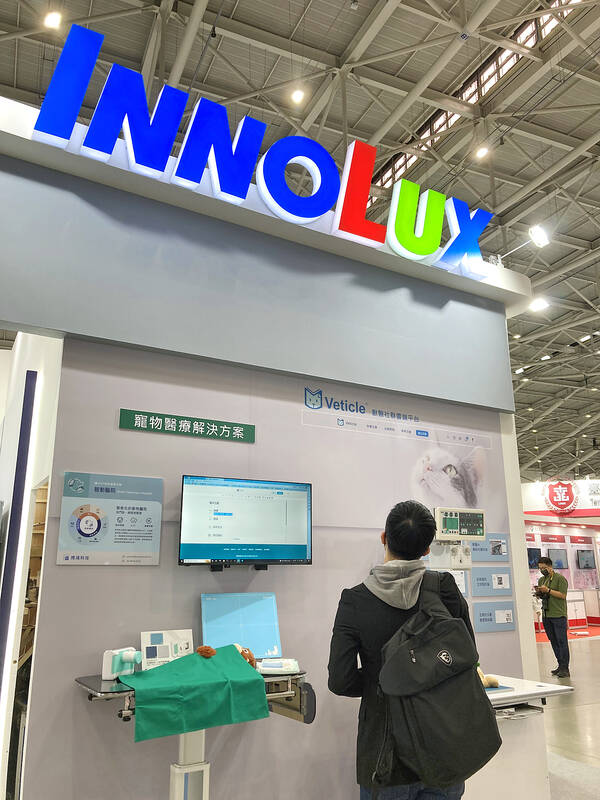Flat panel maker Innolux Corp (群創) yesterday posted a seventh straight unprofitable quarter as global central banks’ interest rate hikes and soaring inflation depressed consumer spending on electronics that led to a supply glut.
To improve the imbalance of supply and demand, Innolux and its global peers have lowered factory utilization last year, the Miaoli-based company said in a statement.
Innolux posted a NT$18.64 billion (US$591.4 million) loss for last year, an improvement from a loss of NT$27.99 billion in 2022. Gross margin swung back to positive territory at 1.5 percent from minus-3.1 percent the previous year.

Photo: Lisa Wang, Taipei Times
During the final quarter of last year, Innolux’s losses widened to NT$3.24 billion, from a loss of NT$1.9 billion in the third quarter as customer demand subsided following the end of year-end shopping season. The average selling price dropped about 3.5 percent sequentially to US$269 per square meter during the final quarter.
Innolux expects the flat panel industry to usher in a growth period this year, thanks to better economic prospects worldwide and new TV replacement demand due to three major sports events, including the Paris Olympics and UEFA Euro 2024.
New artificial intelligence (AI)-enabled devices such as smartphones and PCs are also to drive demand, the Miaoli-based company said in the statement.
Innolux is accelerating its transformation efforts to expand into advanced chip packaging, auto displays and other new businesses beyond flat panels, the statement added.
Shifting away from flat panels would play a crucial role in the company’s transformation as those new businesses would help shield against the boom-and-bust flat panel industry and help the company report stable earnings, Innolux said.
The company in December last year said that its new panel-level-packaging services would start contributing revenue in the second half of this year.
Non-display products made up 28 percent of the company’s total revenue last year, up from 24 percent in 2022.
As the industry enters its off-season, Innolux expects shipments of large flat panels for TVs and PCs to decline by a low single-digit percentage this quarter from the previous quarter.
Overall average selling prices would increase by low single-digit percentage sequentially this quarter, the company forecast.
Innolux plans to spend NT$21 billion on new equipment this year, little changed from NT$21.4 billion last year.

The US dollar was trading at NT$29.7 at 10am today on the Taipei Foreign Exchange, as the New Taiwan dollar gained NT$1.364 from the previous close last week. The NT dollar continued to rise today, after surging 3.07 percent on Friday. After opening at NT$30.91, the NT dollar gained more than NT$1 in just 15 minutes, briefly passing the NT$30 mark. Before the US Department of the Treasury's semi-annual currency report came out, expectations that the NT dollar would keep rising were already building. The NT dollar on Friday closed at NT$31.064, up by NT$0.953 — a 3.07 percent single-day gain. Today,

‘SHORT TERM’: The local currency would likely remain strong in the near term, driven by anticipated US trade pressure, capital inflows and expectations of a US Fed rate cut The US dollar is expected to fall below NT$30 in the near term, as traders anticipate increased pressure from Washington for Taiwan to allow the New Taiwan dollar to appreciate, Cathay United Bank (國泰世華銀行) chief economist Lin Chi-chao (林啟超) said. Following a sharp drop in the greenback against the NT dollar on Friday, Lin told the Central News Agency that the local currency is likely to remain strong in the short term, driven in part by market psychology surrounding anticipated US policy pressure. On Friday, the US dollar fell NT$0.953, or 3.07 percent, closing at NT$31.064 — its lowest level since Jan.

Hong Kong authorities ramped up sales of the local dollar as the greenback’s slide threatened the foreign-exchange peg. The Hong Kong Monetary Authority (HKMA) sold a record HK$60.5 billion (US$7.8 billion) of the city’s currency, according to an alert sent on its Bloomberg page yesterday in Asia, after it tested the upper end of its trading band. That added to the HK$56.1 billion of sales versus the greenback since Friday. The rapid intervention signals efforts from the city’s authorities to limit the local currency’s moves within its HK$7.75 to HK$7.85 per US dollar trading band. Heavy sales of the local dollar by

The Financial Supervisory Commission (FSC) yesterday met with some of the nation’s largest insurance companies as a skyrocketing New Taiwan dollar piles pressure on their hundreds of billions of dollars in US bond investments. The commission has asked some life insurance firms, among the biggest Asian holders of US debt, to discuss how the rapidly strengthening NT dollar has impacted their operations, people familiar with the matter said. The meeting took place as the NT dollar jumped as much as 5 percent yesterday, its biggest intraday gain in more than three decades. The local currency surged as exporters rushed to